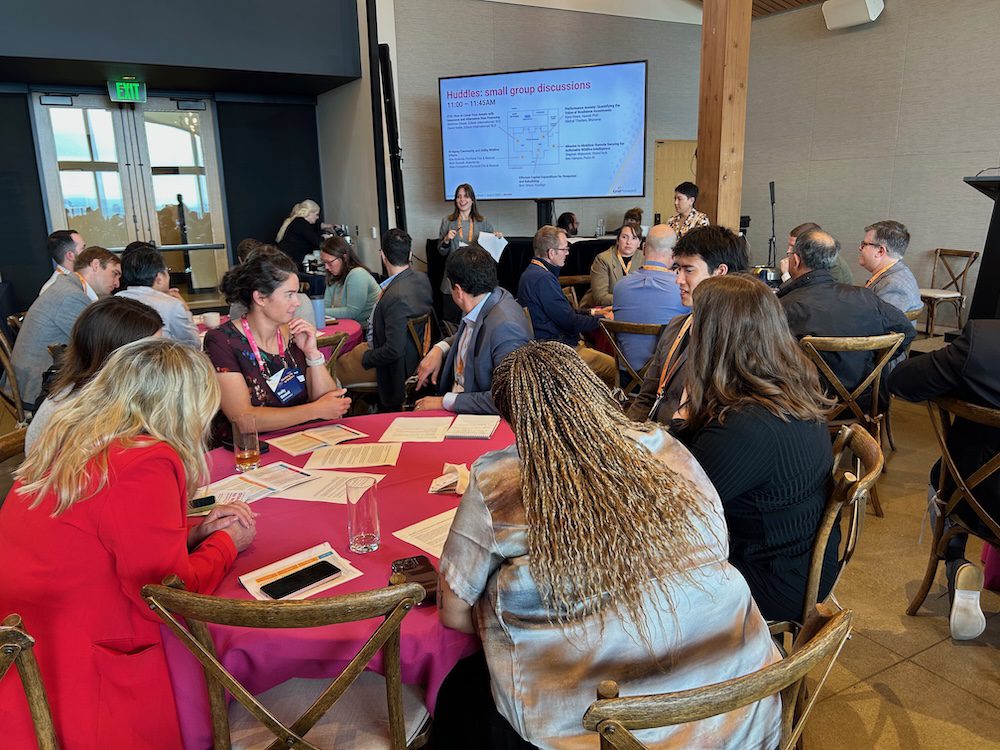Insights gained at the symposium Standing Up to Wildfire: Practical Tech and Tactics for Utilities
By Linda Barney, Barney and Associates
On June 4, 2025, Grid Forward hosted a Symposium ‘Standing up to Wildfire: Practical Tech and Tactics for Utilities’ in Portland, Oregon. Our writer Linda Barnery prepared a lengthy article about what she learned there, which we are republishing as a three-part series here. We published part one a couple of weeks ago, covering the opening plenary with Dave Winnacker, retired Fire Chief and Policy Advisor for the Western Fire Chiefs Association. Part 1 also recapped learnings around “What utilities can do to reduce the risk of starting a wildfire.” Watch for part 3 coming soon.
How utilities can collaborate with first responders and communities to lessen the risk and impact from a wildfire
While I heard about many tools and tactics that utilities can pursue on their own, another clear message was that collaboration with first responders and communities was just as important.
Collaboration with fire agencies and community organizations on wildfire mitigation planning
Puget Sound Energy (PSE) has a service area that spans 6,000 sq. miles primarily in the Puget Sound region of Western Washington. A member of the PSE Wildfire Risk Management team heard from Washington’s regulators about the importance of involving fire suppression and fire response agencies to get their feedback as Wildfire Mitigation plans are developed. PSE is now working with firefighter groups to get their input on operational and tactical responses needed during a wildfire emergency.
Collaboration with other utilities and regulatory agencies on what others are doing
An afternoon panel named Policy and Regulatory Frameworks for Wildfire Resilience covered policy and regulatory frameworks from the perspective of both regulators and utilities. The former Deputy Director of California’s office of Energy encouraged attendees to realize that wildfire mitigation is their problem. Various sessions focused on how to make wildfire mitigation a priority and described what utilities are doing to meet the need.
There were multiple examples of regulators and utilities attendees working together on wildfire resilience during the Symposium. Caroline Thomas Jacobs, Director of the California Office of Energy Infrastructure Safety indicated that utilities are the experts on their Wildfire Mitigation Plans. Jacobs stated, “As regulators, we don’t determine what is included in individual utility Wildfire Mitigation Plans. Our role as regulatory evaluators is to look at this: How are they thinking through it, their decision-making framework, what are they including in that assessment of how they define what that risk is? We’re really looking to the utility to say, how do you understand your risk and what are you doing about it that’s most appropriate for your organizational structure and environment?”

The symposium Standing Up to Wildfire included small-group discussion sessions.
The Washington State Commissioner talked about the importance of providing guidelines for utilities to use in creating Wildfire Mitigation Plans and prioritizing risks. The Washington State Legislature passed House Bill 1522 that requires regulated utilities to submit their wildfire mitigation plans to the state Utilities and Transportation Commission for review and approval. The UTC will be responsible for deciding if the plans are effective, fair, and won’t unnecessarily drive-up costs for customers. Washington HB 1990 authorizes securitization financing for regulated electric, gas, and water utilities, allowing them, with the approval of the Utilities and Transportation Commission, to issue rate recovery bonds for qualifying emergency-related costs. This financing approach reduces the burden on utility customers by spreading costs over time and lowering overall rates compared to traditional recovery methods.
Collaboration about programs for funding
Another source of wildfire program financing has been the federal government. The Department of Energy’s GRIP Wildfire Assessment and Resilience for Networks (WARN) Project and other selected projects set aside funding for grid resilience which will be improved through the strategic deployment of both well-known methods and advanced technologies for grid hardening, grid operations, and condition based maintenance.
Communicate with communities about wildfire severity and what they can do
All speakers described how important it is for the utilities to communicate effectively with their communities, not just during an event, to help prepare them for why they’re making certain investments, or why their power may go off in an emergency.
In one example, Holy Cross Energy holds an informational “Brats and Kilowatts” session at a different community in their area each month. “I’ll have an opportunity to talk to them about high winds and the danger of wildfires and how they can help by trimming vegetation, having a go-bag, making a defensible space, and where to go if there is no power. Resilience is not only planning but requires a constant communication throughout the year,” stated Hannegan.
The President of Xcel Energy indicated that if there is a PSPS condition with high winds and dry vegetation that forces the Xcel utility to shut off power, that they use the following plan to let communities know of a pending power shutdown.
- 72 hours before a PSPS power shutdown, Xcel Energy communicates with emergency management.
- At 48 hours, they communicate with customers, and again at 4 hours before the shutdown.
- During the shutdown, customers need to have outage information, maps, and it is critical to make sure the website can handle web requests.
- Once wind conditions subside, Xcel staff patrol power lines with humans or drones to verify it is safe to turn on power again. Customers often expect power to be restored immediately once winds abate, so it is important to let customers know a realistic timeline when power can safely be turned back on.
Watch for part 3 of this article coming to the Grid Forward blog soon.



